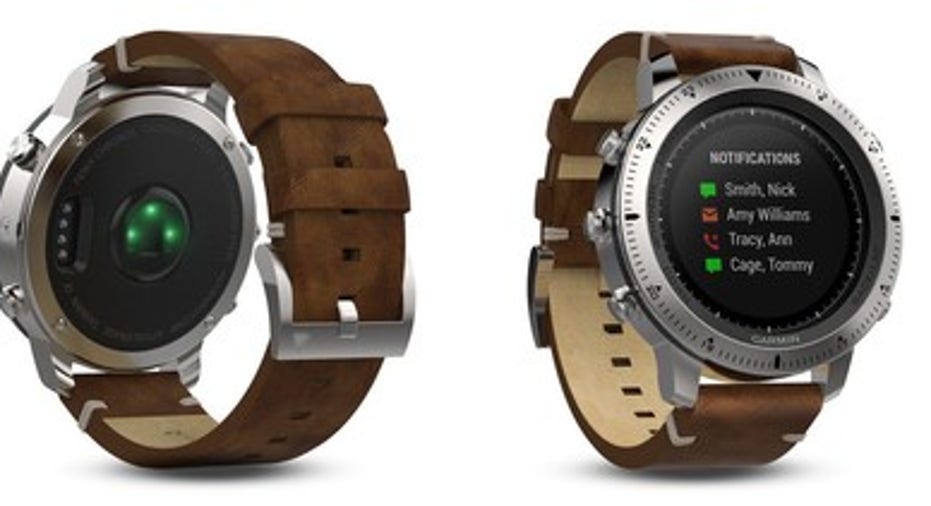Will This Underdog Take Down The Apple Watch?

The Apple (NASDAQ: AAPL) Watch is stillthe top smartwatch in the world with 41.3% market share according to IDC's third quarter numbers. While that sounds like great news for Apple, it actually represents a big decline from its 70.2% share in the prior year quarter. IDC also reported that shipments of the Apple Watch fell 71.6% annually to 1.1 million during the quarter.
Apple Watch Series 2. Image source: Apple.
Meanwhile, Garmin's (NASDAQ: GRMN) shipments surged 324.2% to 600,000, helping it come in second with a 20.5% market share. Garmin also posted the strongest year-over-year growth among the top five vendors, which include Apple, Garmin,Samsung, Lenovo, and Pebble -- in that order.So how did Garmin, a company primarily known as a GPS device maker, make such huge gains in the smartwatch market?
Garmin targets niche markets
Unlike Apple, which promotes the Apple Watch as an "all in one" wearable device for fitness, entertainment, and everyday use, Garmin sells wearables for specific fitness needs. For example, the Approach S6 helps golfers view course maps and measure swing speed and strength. The Garmin Swim records distance, pace, stroke count, and stroke type for swimmers. The popular Forerunner GPS watches -- a major growth driver in recent quarters -- are aimed squarely at runners.
To compete against full-featured smartwatches with their own app ecosystems, Garmin launched the Connect IQ app store. By opening up that app store to developers, Connect IQ devices gained features for new sports, new niche offerings, and watch faces -- making them compelling alternatives to multi-purpose devices like the Apple Watch. To reach the higher end market, Garmin launched the Fenix Chronos, a pricey ($900 to $1,500) watch crafted from"premium jeweler's grade materials."
Garmin's Fenix Chronos. Image source: Garmin.
These efforts boosted Garmin's fitness revenue, which accounted for 26% of its top line, 32% annually last quarter. Robust demand for outdoor wearable devices, which include the Fenix smartwatch lineup, boosted the outdoor segment's revenue by 28%. Growth in those two segments, along with double-digit growth in its marine and aviation GPS units, is now offsetting the ongoing declines in its automotive GPS business.
Is the Apple Watch in trouble?
The two price cuts on the Apple Watch earlier this year, which reduced the price of its cheapest watch from $349 to$269, clearly hinted at weaker-than-expected demand. The new Series 2 Apple Watch -- which adds a GPS, a brighter display, and a "swim-proof" design -- also feels like a direct reaction to Garmin's strength in GPS-enabled, fitness-focused devices.
A key problem for the Apple Watch is that it's only compatible with iOS devices, which limitsit to about 12% of smartphone users worldwide. Yet a wide variety of non-Apple smartwatches -- including Android Wear, Pebble, and Garmin devices -- all pair with iPhones. While it's understandable that Apple wants to sell the Watch as an "exclusive" device for iPhone owners, it could also boost sales considerably by adding Android compatibility. After all, Apple would probably have sold a lot fewer iPhones, iPads, and iPods if they could only be connected to Macs.
Since the Apple Watch is still often considered a niche device among iPhone owners, its growth will likely peak unless Apple adds "must have" features to the Apple Watch. Unfortunately, there just aren't enough "must have" features on the Apple Watch to justify the purchase for most consumers.
A survey by Quartz using SurveyMonkey Audience in July found that less than 5% ofiPhone owners who didn't already own an Apple Watch would likely buy a new Apple Watch this year. Of the respondents who already owned one, just 17% were likely to upgrade to a new model this year.
A growth driver for Garmin, a missed opportunity for Apple
Garmin's growth in the wearables market represents a solid turnaround effort for the underappreciated GPS maker. If that growth continues, the slow death of its automotive GPS business unit won't leave a gaping hole in its top line, which is expected to rise 3% this year.
Meanwhile, weak sales of the Apple Watch won't hurt Apple that much, since most of its revenue still comes from the iPhone, iPad, and Mac. But it represents a missed opportunity for the tech giant, and raises serious questions about Apple's ability to innovate beyond the three core product lines established by Steve Jobs.
A secret billion-dollar stock opportunity The world's biggest tech company forgot to show you something, but a few Wall Street analysts and the Fool didn't miss a beat: There's a small company that's powering their brand-new gadgets and the coming revolution in technology. And we think its stock price has nearly unlimited room to run for early in-the-know investors! To be one of them, just click here.
Leo Sun has no position in any stocks mentioned. The Motley Fool owns shares of and recommends Apple. The Motley Fool has the following options: long January 2018 $90 calls on Apple and short January 2018 $95 calls on Apple. Try any of our Foolish newsletter services free for 30 days. We Fools may not all hold the same opinions, but we all believe that considering a diverse range of insights makes us better investors. The Motley Fool has a disclosure policy.